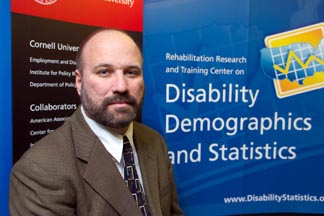Gap widens between working-age people with and without disabilities in the workforce, reports shows
By Linda Myers
WASHINGTON, D.C. -- Between 2003 and 2004 the employment gap widened between the number of working-age Americans with disabilities who are employed and those workers without disabilities, a new report released today (Oct. 5) on Capitol Hill shows.
The finding, which coincides with the start of National Disability Employment Awareness Month, was part of a series of reports released by Cornell University in collaboration with the American Association of People with Disabilities (AAPD).

The researchers found that in 2004 the "employment gap" between those with disabilities in the workforce and those workers without disabilities was 40.3 percent. That represents a .6 percentage point increase from 2003, when the gap was 39.7 percent.
The growth in the gap means that there are fewer people with disabilities in the workforce relative to the total number of Americans employed. "The rise in the employment gap suggests that people with disabilities are not participating in the recovery from the 2001 recession," said Andrew Houtenville, director of the Cornell's Rehabilitation Research and Training Center on Disability Demographics and Statistics (StatsRRTC).
The first Annual Disability Status Reports from Cornell, which contain a range of statistics about people with disabilities, including statistics by state, are available online at http://www.DisabilityStatistics.org.
The reports, which will be issued yearly at the beginning of October by Cornell, "fill a pressing need for timely and relevant statistics about people with disabilities," said Houtenville. "We hope they will become an annual event that policy-makers, advocates, the media and people with disabilities across the United States will anticipate and depend on," he said.
Another key finding in the reports: The poverty rate rose more between 2004 and 2003 for people with disabilities than for those without. For people with disabilities, it increased .8 percentage points, to 24.1 percent of working-age Americans in 2004, from 23.3 percent in 2003. For people without disabilities it increased .2 percentage points, to 9.1 percent, from 8.9 percent.
Robert Weathers, senior research associate at Cornell's Employment and Disability Institute, said, "The findings about the overall rise in poverty are consistent with the recent Census Bureau announcement that the poverty rate increased in the United States between 2003 and 2004." The Disability Status Reports use the American Community Survey -- the public-use version of the raw data that the Census Bureau uses in its report, Weathers said.
Some Cornell researchers are investigating whether the employment gap may be due, in part, to what they call the "poverty trap." Under current federal rules, people with disabilities must be essentially unemployed to receive government benefits, but the support they receive isn't enough to keep them out of poverty, they point out.
"Those with the lowest incomes lose 50 cents for every dollar they earn. That's a higher tax rate than Bill Gates pays," said David Stapleton, director of the Cornell Institute for Policy Research. Stapleton and others recommend that federal policy be revisited to reward, rather than punish, people with disabilities who earn income through employment.
The Cornell reports also showed that the employment rate of working-age people without disabilities was 77.6 percent in 2003, compared with 37.9 percent for working-age people with disabilities that year. In 2004, the employment rate for people without disabilities rose .2 percentage points, to 77.8 percent, while the employment rate of people with disabilities declined .4 percentage points, to 37.5 percent.
The StatsRRTC is the statistics arm of three Cornell units: the Employment and Disability Institute in the School of Industrial and Labor Relations, the Institute for Policy Research located in Washington, D.C., and the Department of Policy Analysis and Management in the College of Human Ecology. It is funded by the National Institute on Disability and Rehabilitation Research.
Media Contact
Get Cornell news delivered right to your inbox.
Subscribe